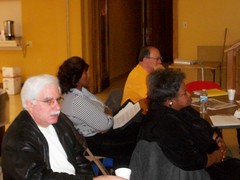
Members of the Moratorium NOW! Coalition attending a meeting at the Central United Methodist Church on Nov. 20 in Detroit. The meeting was called by the People Before Banks Coalition. (Photo: Abayomi Azikiwe)
Originally uploaded by Pan-African News Wire File Photos
By JEAN EAGLESHAM
Wall Street Journal
More than 300 U.S. banks and savings institutions failed in the past four years. But there are huge differences in how sick they were when regulators seized them.
About a dozen of the dead financial institutions had a tangible common equity ratio, a widely used measurement of a bank's cushion to absorb losses, of more than 8% when they failed, according to an analysis by Keefe, Bruyette & Woods Inc. That isn't much worse than the median ratio of 9% among the 50 companies in the investment bank's regional-bank stock index.
In contrast, a total of 50 failed banks had negative capital by the time regulators swooped in, meaning their capital was depleted by losses. And those shutdowns came as long as two years after government officials issued their first warning about financial inadequacies, analysts at the KBW Inc. unit found.
Timur Braziler, an analyst at Keefe, Bruyette & Woods, says the differences are a sign that "bank regulators and state officials simply can't get to these banks fast enough," citing the 860 battered institutions on the Federal Deposit Insurance Corp.'s "problem list" as of Sept. 30. "There's just not enough manpower and coordination to catch all these failing institutions at once."
Killing a bank too soon could mean getting rid of a financial institution that might recover to make solid, profitable loans. Waiting until all of a bank's capital is gone deepens the losses suffered by the FDIC's deposit-insurance fund, putting additional strain on surviving banks that pay into the fund.
The demise of Imperial Savings & Loan in Martinsville, Va., is expected to cost the FDIC's insurance fund $3.5 million.
FDIC officials dispute any suggestion that the agency has been overwhelmed by the U.S. banking industry's crisis or inconsistent in how it handles failed financial institutions.
The FDIC's division of resolutions and receiverships, the mortuary for fatally stricken banks and thrifts, has 2,133 employees, up from 219 in 2007. That includes more than 50 veterans of the savings-and-loan crisis who came out of retirement to deal with a new crop of dead banks.
The decision about when to seize a battered bank is complicated by the hodgepodge of regulators that oversee the nation's 7,760 federally insured financial institutions. Some state officials aren't allowed by law to close a bank unless they can prove it has burned through all its capital. Federal officials have more leeway and can shut down a bank even if it isn't yet "critically undercapitalized," the lowest rung on the regulatory ladder.
"It is always difficult for regulators to decide when to close a bank," says Thomas Vartanian, a partner at law firm Dechert LLP and general counsel of the Federal Home Loan Bank Board during the Reagan administration. "Often, they are trying to strike a balance between giving failing banks every chance of survival by allowing them time to pursue potential suitors, and seizing them too late to minimize the cost to the FDIC."
James Wigand, a longtime FDIC official, says it is a "difficult judgment to make," though "for the most, part history will judge that the regulators got it right" during the banking industry's latest crisis. On Dec. 31, Mr. Wigand will become director of a new FDIC unit overseeing systemically important financial firms. The post was created as a result of the Dodd-Frank financial-overhaul law.
Some of the banks classified by regulators as well-capitalized at the time of their failure were dragged down by a parent company that collapsed. Two of the nine banks owned by FBOP Corp., a bank-holding company in Oak Park, Ill., had a tangible common equity ratio of more than 10% when the bank-holding company was seized by regulators in October 2009. At other banks, losses ballooned shortly after regulators examined their financial statements and loan files, causing sudden death.
The Keefe, Bruyette & Woods analysis includes failures from February 2007 to July 2010. A total of 157 banks have been seized in 2010, up from 140 in 2009.
Imperial Savings & Loan Association, based in Martinsville, Va., failed in August, more than a year after losses left the tiny thrift with negative capital. The demise is expected to cost the FDIC's insurance fund $3.5 million.
William Cody Spencer founded Imperial in July 1929, using $300 of savings from fellow Baptist church members, running the minority-owned thrift from his home for 30 years. In 2008, the Office of Thrift Supervision issued a formal warning about Imperial's deteriorating financial condition.
Daniel Thibeault, co-founder of a student-loan business in Cambridge, Mass., says he made "six or seven submissions to the OTS" in an effort to buy Imperial before it was seized, offering to pour in $6 million in capital immediately and an additional $6 million within 18 months.
"Short of popping the champagne, we were 98% close to getting this deal," he says, complaining he "never got a straight answer" from the OTS about why he was spurned.
In a statement, the OTS says the "potential acquirers were unable to demonstrate the viability of their proposals by showing they possessed the expertise and the financial resources to operate a financial institution." The agency says it made "an extraordinary effort over several years by working aggressively with multiple groups of potential investors interested in acquiring Imperial."
Ronald Haley, president of River Community Bank, a unit of River Bancorp Inc., also of Martinsville, that bought Imperial after it failed, says "it was just too small to function in the banking world today."
No comments:
Post a Comment